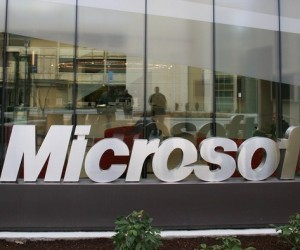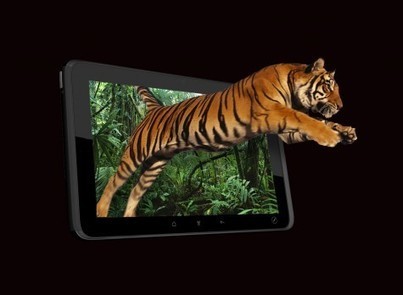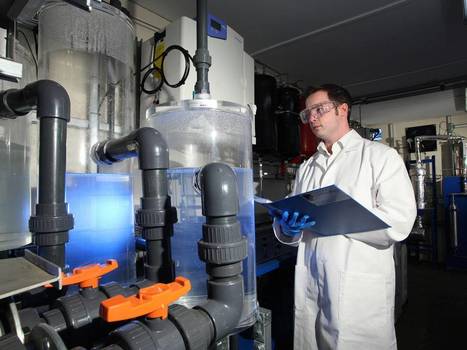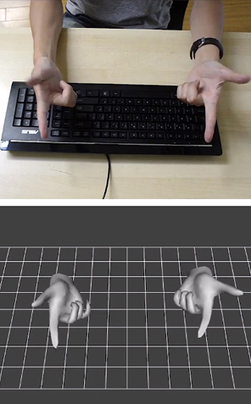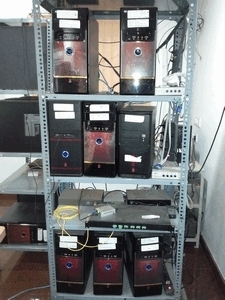 Your new post is loading...
 Your new post is loading...
A startup hopes to connect millions of low-power sensors worldwide to the Internet, making everything—from power grids to home appliances—smarter. All of the apps, movies, and games consumed on tablets and phones are only available because cellular networks deployed wireless technology to connect people to the Internet wherever they are. French startup SigFox thinks it can help usher in a second mobile Internet boom—by building cellular networks to serve not people but, well, things. SigFox is focused on connecting cheap sensors and “dumb” home appliances to the Internet. The goal is to make all kinds of appliances and infrastructure, from power grids to microwave ovens, smarter by letting them share data. The general concept, known as “the Internet of Things,” has been discussed in academic circles for years, but it has yet to come to life.
By combining chemistry, processing and engineering expertise, IBM researchers have come up with a new chip technology that would allow the industry to get more powerful, yet smaller with lower power consuming chips. It may take more than a decade before the technology become commercially viable.
NanoTech Entertainment today announced it has completed its development of a new proprietary technology, NanoFlix3D. NanoTech Media, the IPTV division of NanoTech Entertainment, is now offering content providers and publishers a unique set of tools for the creation of fully immersion 3D TV Channels and Smart TV apps. NanoFlix3D is now available on the Roku IPTV platform, and will be available on Samsung Smart TV, LG Smart TV as well as several other platforms. NanoTech Media has the only fully immersive 3D user interface available on the Roku platform. The proprietary system provides users with a continuous 3D experience from the moment the channel is launched. Unlike other so called 3D channels, users don’t have to toggle their TV back and forth between 2D mode and 3D mode every time they use the menu to select 3D content for viewing.
MIT spinoff company, Eta Devices has achieved a breakthrough in the power amplifiers and promises that it would almost double your smartphone battery life. What this means is that your iPhone will actually last longer than 10 hours and your Android will live for more than a day even for the power users. The company says that they’ll begin the commercial production in 2013 and will demo it at the Mobile World Congress in Spain. The company wants to aim the developing world first but the technology would definitely be adapted my all the mobile hardware makers.
Roland Vlaicu, Dolby, is telling the industry that full HD glasses free 3D does not need to wait, as the company pushes its platform agnostic, backwards compatible Dolby 3D solution. There has been a focus of the potential of Dolby 3D for glasses free 3D solutions but it is a group of algorithms that would work with glasses based systems too. The company is currently talking to chip manufacturers, broadcasters and TV hardware companies to embed Dolby 3D codecs for the delivery of full HD 3D to any 3D display.
In this interview, we aim to discover how Dolby 3D can deliver a high enough quality experience and what evidence supports the notion that 3D will take off if the glasses could be chucked out of the equation.
Parallel computing for everyone promised with 16- and 64-core boards. Chipmaker Adapteva wants to make parallel computing available to everyone, but there’s a good chance you’ve never even heard the company’s name. Founded in 2008, Adapteva focuses on building low-power RISC chips, which it sells to board manufacturers, and is trying to license its intellectual property to mobile processor vendors for use in smartphones. Adapteva calls it “Parallella: A Supercomputer For Everyone,” a 16-core board hitting 13GHz and 26 gigaflops performance, costing $99 each. If the $3 million goal is hit, Adapteva will make a $199 64-core board hitting 45GHz and 90 gigaflops. (Adapteva seems to be counting GHz on a cumulative basis, adding up all the cores.) Both include a dual-core ARM A9-based system-on-chip, with the 16- and 64-core RISC chips acting as coprocessors to speed up tasks. The Adapteva architecture hits performance of 70 gigaflops per watt, and 25GHz per watt, the company says.
What do you do when you need a high-end Mac — for editing video, retouching photos, recording music, animating 3D graphics, or just playing games — but you can’t afford a Mac Pro? Build one out of PC components. Yes, it’s possible to take off-the-shelf PC parts and build a Mac with your bare hands. It takes a D.I.Y attitude and a sense of adventure, but the result — a machine that’s faster than the entry-level Mac Pro, for half the price — is worth it. I wrote this how-to with video editors and other creatives in mind, but this hackintosh will work for anyone looking to get more bang for the buck out of a Mac.
Photos of the mystery computing device appeared on the web in late February. Taken with a smartphone, they were a bit washed out and a little blurry in places, but you could easily read the name printed on the long, thin piece of hardware. “Pluto Switch,” the label said. The images were posted by two men who said the device had unexpectedly turned up at a branch office in the tiny farmland town of Shelby, Iowa — population: 641 — and they were hoping someone could tell them what it was. Clearly, these two men were familiar with the ins and outs of computer networking, and clearly, this was a networking switch, a way of shuttling data between machines. But they’d never heard of the Pluto Switch, and it was littered with networking ports they’d never seen before. “Any ideas?” they asked. “The writing on the back is Finnish.” According to posts they made to an obscure web discussion forum dedicated to networking hardware — networking-forum.com — they couldn’t actually get the thing to work. But they turned up a few clues indicating who the device belonged to, and eventually, after putting two and two together, they said they’d located the owner and sent the switch back. It belonged, they said, to Google.
California-based company Aerofex has developed a working prototype of their Tandem Duct Aerial Vehicle, a hover vehicle that looks like it came straight out of Star Wars Episode VI: Return of the Jedi. While still in the early stages, they have demonstrated that it works in the Mojave Desert (video 1, 2). According to InnovationNewsDaily, another prototype is expected to be released in October 2012 and an unmanned drone version in 2014.
Watching 3-D movies generally means suffering through two things: crappy plotlines that favor spectacle over substance and the need to wear some annoying, dorky glasses. Scientists may have solved one of these frustrations. (You might be able to guess which.) Researchers in South Korea have created a new method that would allow moviegoers to simply sit down and start watching a 3-D movie with no extra gear necessary. The research was published today in Optics Express. The new method would allow movie theaters to keep their projectors where they’ve always been, behind the audience, and uses fairly simple optical technology. A special array sits in front of the projector and polarizes its light. A filter covering the screen then obscures different vertical regions of the screen, like the slats of venetian blinds. Each of your eyes, sitting at a slightly different angle, has some of the screen blocked and some of the screen visible. The movie has the right-eye and left-eye images interleaved in vertical columns with one another. The trick then is to have the light visible to your left eye contain the left-eye pixels and vice versa for the right eye.
Large-scale motion and gesture-controlled computing is no longer confined to science fiction movies, as Los Angeles-based Oblong Industries again demonstrates its exciting software that gives users a fresh new way to interact with computers. Dubbed “g-speak,” Oblong calls its software a spatial operating environment — and just as Tom Cruise and Collin Farrell did with the computer in Steven Spielberg’s “Minority Report,” users can control g-speak by wearing a special glove and performing gestures in the air.
The traditional remote control is dead. Nowadays the remote has become a small hand-held computer which allows you to operate much more than just switching channels and the volume. Over-the-top systems like Boxee and AppleTV have released smartphone apps to control what you’re watching and to sync with your personal media center. In gaming the Wii brought a revolution using motion as a controller and last year the Xbox Kinect allowed you to used 3D gestures to operate the screen. And now there's the Leap : a new meaning to the concept of motion control by allowing users to use complex 3D gestures to control whatever is on the screen... WATCH VIDEO : http://bit.ly/MNRj7H ;
An international team of researchers have managed to achieve data transmission speeds of 2.5 terabits per second by “twisting” light waves. They believe the same technique could also be used for more traditional wireless transmission. The technique involves controlling the movement of light waves in two different ways: the spin angular momentum (which is already controlled in radio wave transmissions) and the orbital angular momentum (which has not previously been controlled.)
|
Microsoft has today posted a video, and complementary explanation of language translation that goes far past what we thought was currently possible. In the video, the speaker explains and demonstrates improvements made to the machine understanding of his English words, which are automatically transcribed as he speaks. He then demonstrates having those words translated directly into Mandarin – if it’s actually Cantonese I’ll punish myself – text.
Microsoft plans to offer devices based on Perceptive Pixel technology that uses both pen and touch to create what is equivalent to the human as the user interface.
The NEO3DO Android tablet features an 8” 1280 x 768 resolution glasses free 3D touch display, 1GB of RAM, a front (0.3 Megapixel) and rear (2.0 Megapixel) camera, a gravity acceleration sensor and Wi-Fi connection. The screen uses lenticular LCD technology to support 3D viewing which can be 3D image formats such as JPEG 3D and MPO – 3D and 3D video formats such as MPO video, JPG (L/R Interleaving) and Side-by-Side so YouTube 3D video can be watched without glasses.
Is scientific breakthrough a milestone on the road to clean energy? A small British company has produced the first "petrol from air" using a revolutionary technology that promises to solve the energy crisis as well as helping to curb global warming by removing carbon dioxide from the atmosphere.
DaVinci 3D ROKU Channel Rocks 3D Summit with 3D Auto Conversion and AS3D Breakthrough. DaVinci 3D premiered their line of AS3D hardware and software advancements at the 3D Entertainment Summit in LA. They debuted their Auto Stereoscopic 3DTV, glasses free small screen LCD television package which included 2D/3D content conversion and a Sneak preview of their ROKU 3D Channel. Da Vinci 3D, founder and CEO Stephen Blumenthal stated, “DaVinci 3D’s mission is to bring to the consumer market the first “ REAL 3DTV”. DaVinci 3D has the only Broadcast Quality, AS3D with adjustable depth controls, visual comfort, no viewing restrictions and operating as a seamless replacement for HDTV. By marrying classical 3D optics with PC processing, we have created the next generation in 3DTV.”
A startup uses 3-D cameras to keep track of hands and fingers, enabling more complex gesture control. Microsoft's Kinect, a 3-D camera and software for gaming, has made a big impact since its launch in 2010. Eight million devices were sold in the product's first two months on the market as people clamored to play video games with their entire bodies in lieu of handheld controllers. But while Kinect is great for full-body gaming, it isn't useful as an interface for personal computing, in part because its algorithms can't quickly and accurately detect hand and finger movements. Now a San Francisco-based startup called 3Gear has developed a gesture interface that can track fast-moving fingers. Today the company will release an early version of its software to programmers. The setup requires two 3-D cameras positioned above the user to the right and left.
The company’s CTO, Richard A. Muller, is a professor of physics at the University of California, Berkeley and he created the ‘Soliddd equation” after years of research. From what 3D Focus has seen, this lenticular based system vastly improves on what is available now with sharp pictures, huge depth and wider viewing zones. This is due to a greater understanding of the optics according to Neal Weinstock, the Chief Executive Officer.
“We soon discovered the other lenses in the world had been highly inaccurate. Nobody realised just how good autostereo displays can be and so people were not trying to manufacture as accurately as they should be doing.” he told us.
The system offers a 10 degree viewing angle repeated several times across the overall viewing cone. Neal tells us that they have the capability to offer more views than others. Most offer eight or nine views but Soliddd’s close up lens typically has 60 views. These extra views can be used for both movement and depth simultaneously.
3D Focus can reveal that Stream TV Networks will announce a high resolution 4K glasses free 3D TV suitable for the home at IFA. At 13.30 in Berlin, the Philadelphia based company will talk about the Ultra-D 2160p – an autostereoscopic 60” 3D TV that multiple people can watch without any viewing restrictions. Unlike rival displays, there are no ‘jumps’ in the 3D effect when a viewer moves his or her head.
When it comes to storing information, hard drives don’t hold a candle to DNA. Our genetic code packs billions of gigabytes into a single gram. A mere milligram of the molecule could encode the complete text of every book in the Library of Congress and have plenty of room to spare. All of this has been mostly theoretical — until now. In a new study, researchers stored an entire genetics textbook in less than a picogram of DNA — one trillionth of a gram — an advance that could revolutionize our ability to save data. A few teams have tried to write data into the genomes of living cells. But the approach has a couple of disadvantages. First, cells die — not a good way to lose your term paper. They also replicate, introducing new mutations over time that can change the data. To get around these problems, a team led by George Church, a synthetic biologist at Harvard Medical School in Boston, created a DNA information-archiving system that uses no cells at all.
California-based Double Robotics has come up with a piece of kit, called Double, that turns your iPad into a telepresence robot. Cost? $1,999.
Imagine you’re at your company, seated at your desk, when this iPad perched on a kind of pared-down Segway rolls up beside you. On the screen is the face of one of your co-workers located in another country who today is poking about your office, getting to know the layout, meeting some new people, asking a few questions. After a brief chat, it rolls off to the other side of the office. You look up five minutes later and do a double-take as you notice two of these devices having a conversation with each other by the water cooler.
Thanks to Double Robotics’ iPad-on-wheels – otherwise known as ‘Double’ – such a scenario could one day become a reality.
Watch it in action : http://player.vimeo.com/video/47000322
It only works at night, but the technique sets a new distance record. Sending signals through fiber optic cable is reliable and fast, but because of internal absorption and other effects, they will lose photons—which is a problem when the number of photons being sent is small. This is of particular concern in quantum networks, which typically involve a small number of entangled photons. Direct transmission through free space (vacuum or air) experiences less photon loss, but it's very difficult to align a distant receiver perfectly with the transmitter so that photons arrive at their destination. A group in China has made significant progress toward solving that problem, via a high accuracy pointing and tracking system. Using this method, Juan Yin and colleagues performed quantum teleportation (copying of a quantum state) using multiple entangled photons through open air between two stations 97 kilometers apart across a lake. Additionally, they demonstrated entanglement between two receivers separated by 101.8km, transmitted by a station on an island roughly halfway between them.
We are a startup named QuickoLabs based out of Bangalore, India. Our product SearchEnabler, is on-demand SEO software which crawls and analyzes user’s website to provide recommendations, helping them improve their website ranking in search engine results. Our goal is to make SEO easy, affordable & measurable for start-ups and small businesses. To realize our goal, we wanted to ensure minimum cost is incurred in our operations without compromising on product capability. Today our infrastructure holds more than 8TB of data collected from web and processes nearly 250 GB of data everyday. It consists of more than 700 Million unique URLs and analyzed more than 35 million webpages. This numbers will grow quickly as customer base increases. Our infrastructure currently manages: 2 Applications Servers
5 Cassandra Nodes
4 Task Trackers
9 Data Nodes We have used following open source software’s to setup 24×7 crawling, distributed storage and processing : - Hadoop HDFS - Cassandra NoSQL Storage - Hadoop Map-Reduce Tasks - Pig Scripts - Zookeeper for co-ordination - Apache Nutch Search Engine - Text Processing Through Lucene
|



 Your new post is loading...
Your new post is loading...

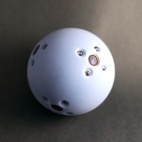










![‘Minority Report’ software becomes a reality [video] | TechWatch | Scoop.it](https://img.scoop.it/L-KxPuOLg-pD_Jrip6wb2Dl72eJkfbmt4t8yenImKBVvK0kTmF0xjctABnaLJIm9)


